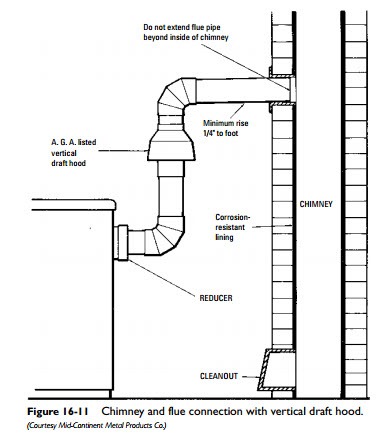Call today for immediate assistance with your furnace
Furnace parts and components
An oil furnace has many essential parts and components. These include fuel pumps, nozzles, blower wheels, combustion chambers, transformers, filters, electrodes and burner tubes, burner heads, fan limit controls, gaskets, furnace alarms and oil lines. One of the main components of an oil furnace is a properly installed flue pipe, which adds to the safety and comfort of your oil furnace’s function.
What’s a flue pipe?
 You may be wondering what a flue pipe is, and how it is installed as part of your oil furnace. A flue pipe is a metal pipe that either stands alone as a chimney pipe leading from a furnace, or runs inside a masonry chimney. In the old masonry chimneys, the tile flues can crack or break over time due to the effects of repeated heating and cooling of the air inside the chimney. Soot can build up inside of these cracks and lead to dangerous chimney fires, so a flue pipe can help avoid these fires. The flue pipe also carries out the smoke and fumes from the living space of a building into the atmosphere. To keep the flue pipe working well, it must be regularly cleaned and maintained. A flue temperature sensor kit can come in handy too. The flue is cool to the touch on the exterior, with decorative caps or covers used to present a more attractive view to the public.
You may be wondering what a flue pipe is, and how it is installed as part of your oil furnace. A flue pipe is a metal pipe that either stands alone as a chimney pipe leading from a furnace, or runs inside a masonry chimney. In the old masonry chimneys, the tile flues can crack or break over time due to the effects of repeated heating and cooling of the air inside the chimney. Soot can build up inside of these cracks and lead to dangerous chimney fires, so a flue pipe can help avoid these fires. The flue pipe also carries out the smoke and fumes from the living space of a building into the atmosphere. To keep the flue pipe working well, it must be regularly cleaned and maintained. A flue temperature sensor kit can come in handy too. The flue is cool to the touch on the exterior, with decorative caps or covers used to present a more attractive view to the public.
There are three types of flues, including fireplace, furnace and water heater flues. For a fire place, the flue is located within the chimney and are straight to enable the best draft. The flue acts as a vent to prevent the byproducts of combustion from seeping back into the room and endangering household occupants. The furnace flue pipe is made of metal and is covered by an insulating material. It has the same function as a fireplace fluepipe, which is to expel the waste products of combustion through an exhaust vent, and prevent accidental fires indoors. A water heater flue pipe fits above the water heater burner, extending upwards and is usually located centrally in the heater. Combustion gases are transmitted from the heater and expelled to the outside atmosphere to prevent carbon monoxide poisoning.
How much does a flue pipe cost?
If you need to install or replace a flue pipe, just give us a call and we can provide you with the approximate cost for a new one. Online results show that the Imperial Manufacturing Group has a 4 inch x 24 inch galvanized furnace pipe on sale for around $30. Contact us at Domino’s Furnace Service for our recommendation on a flue pipe that fits your building and works with your oil furnace.



